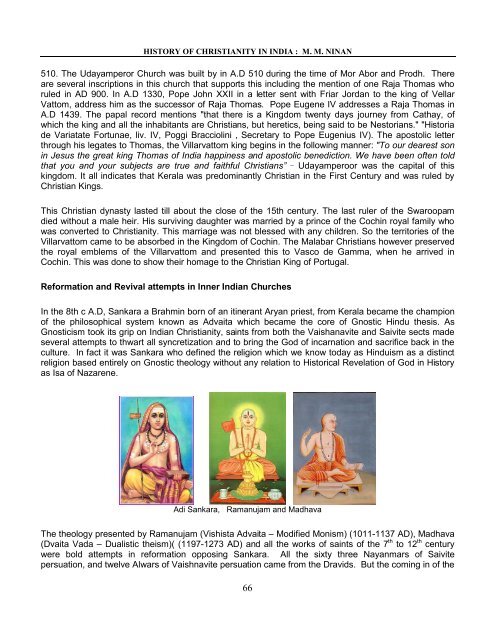Indian Christianity
You also want an ePaper? Increase the reach of your titles
YUMPU automatically turns print PDFs into web optimized ePapers that Google loves.
HISTORY OF CHRISTIANITY IN INDIA : M. M. NINAN<br />
510. The Udayamperor Church was built by in A.D 510 during the time of Mor Abor and Prodh. There<br />
are several inscriptions in this church that supports this including the mention of one Raja Thomas who<br />
ruled in AD 900. In A.D 1330, Pope John XXII in a letter sent with Friar Jordan to the king of Vellar<br />
Vattom, address him as the successor of Raja Thomas. Pope Eugene IV addresses a Raja Thomas in<br />
A.D 1439. The papal record mentions "that there is a Kingdom twenty days journey from Cathay, of<br />
which the king and all the inhabitants are Christians, but heretics, being said to be Nestorians." "Historia<br />
de Variatate Fortunae, liv. IV, Poggi Bracciolini , Secretary to Pope Eugenius IV). The apostolic letter<br />
through his legates to Thomas, the Villarvattom king begins in the following manner: "To our dearest son<br />
in Jesus the great king Thomas of India happiness and apostolic benediction. We have been often told<br />
that you and your subjects are true and faithful Christians” Udayamperoor was the capital of this<br />
kingdom. It all indicates that Kerala was predominantly Christian in the First Century and was ruled by<br />
Christian Kings.<br />
This Christian dynasty lasted till about the close of the 15th century. The last ruler of the Swaroopam<br />
died without a male heir. His surviving daughter was married by a prince of the Cochin royal family who<br />
was converted to <strong>Christianity</strong>. This marriage was not blessed with any children. So the territories of the<br />
Villarvattom came to be absorbed in the Kingdom of Cochin. The Malabar Christians however preserved<br />
the royal emblems of the Villarvattom and presented this to Vasco de Gamma, when he arrived in<br />
Cochin. This was done to show their homage to the Christian King of Portugal.<br />
Reformation and Revival attempts in Inner <strong>Indian</strong> Churches<br />
In the 8th c A.D, Sankara a Brahmin born of an itinerant Aryan priest, from Kerala became the champion<br />
of the philosophical system known as Advaita which became the core of Gnostic Hindu thesis. As<br />
Gnosticism took its grip on <strong>Indian</strong> <strong>Christianity</strong>, saints from both the Vaishanavite and Saivite sects made<br />
several attempts to thwart all syncretization and to bring the God of incarnation and sacrifice back in the<br />
culture. In fact it was Sankara who defined the religion which we know today as Hinduism as a distinct<br />
religion based entirely on Gnostic theology without any relation to Historical Revelation of God in History<br />
as Isa of Nazarene.<br />
Adi Sankara, Ramanujam and Madhava<br />
The theology presented by Ramanujam (Vishista Advaita – Modified Monism) (1011-1137 AD), Madhava<br />
(Dvaita Vada – Dualistic theism)( (1197-1273 AD) and all the works of saints of the 7 th to 12 th century<br />
were bold attempts in reformation opposing Sankara. All the sixty three Nayanmars of Saivite<br />
persuation, and twelve Alwars of Vaishnavite persuation came from the Dravids. But the coming in of the<br />
66


















